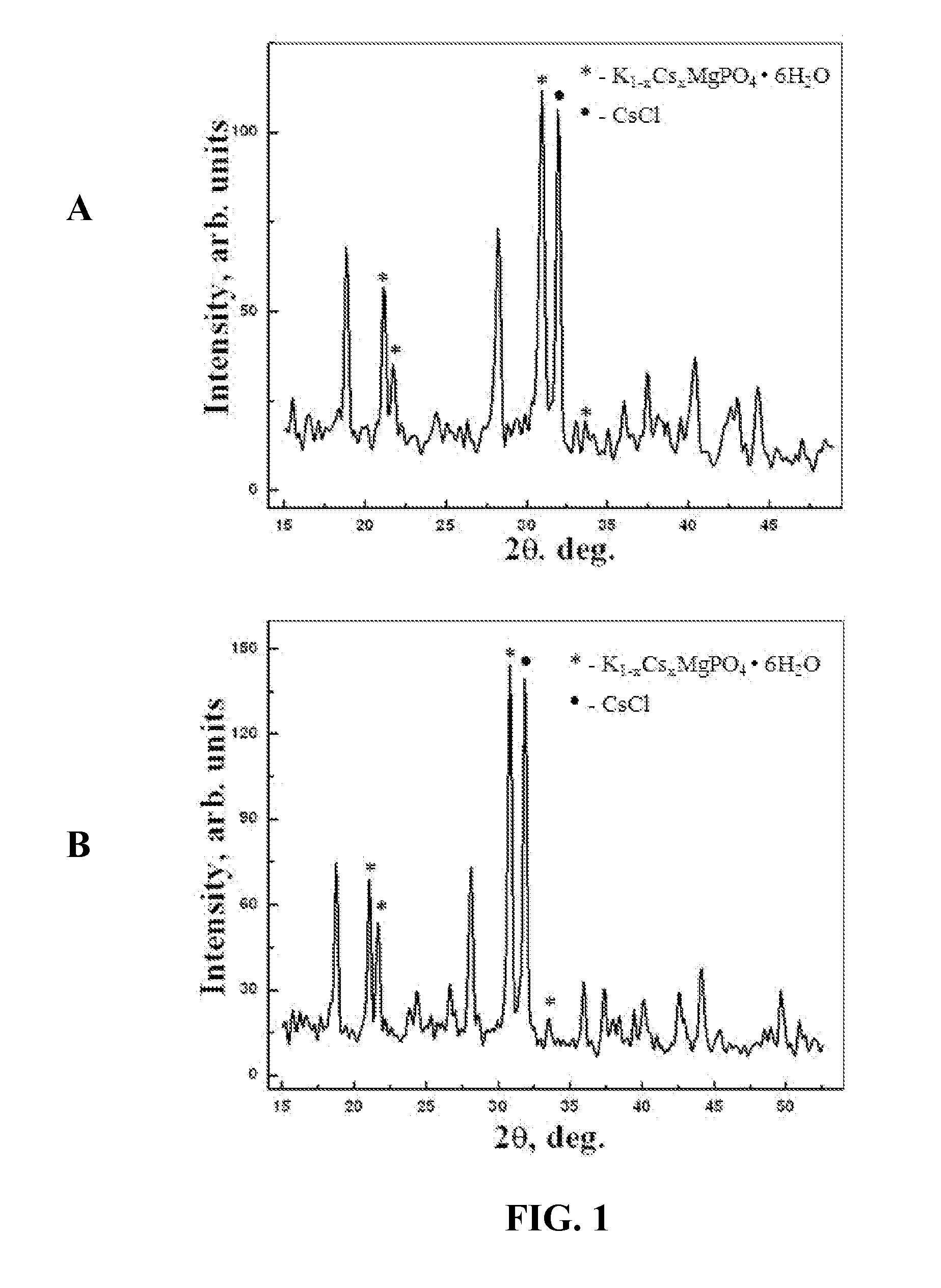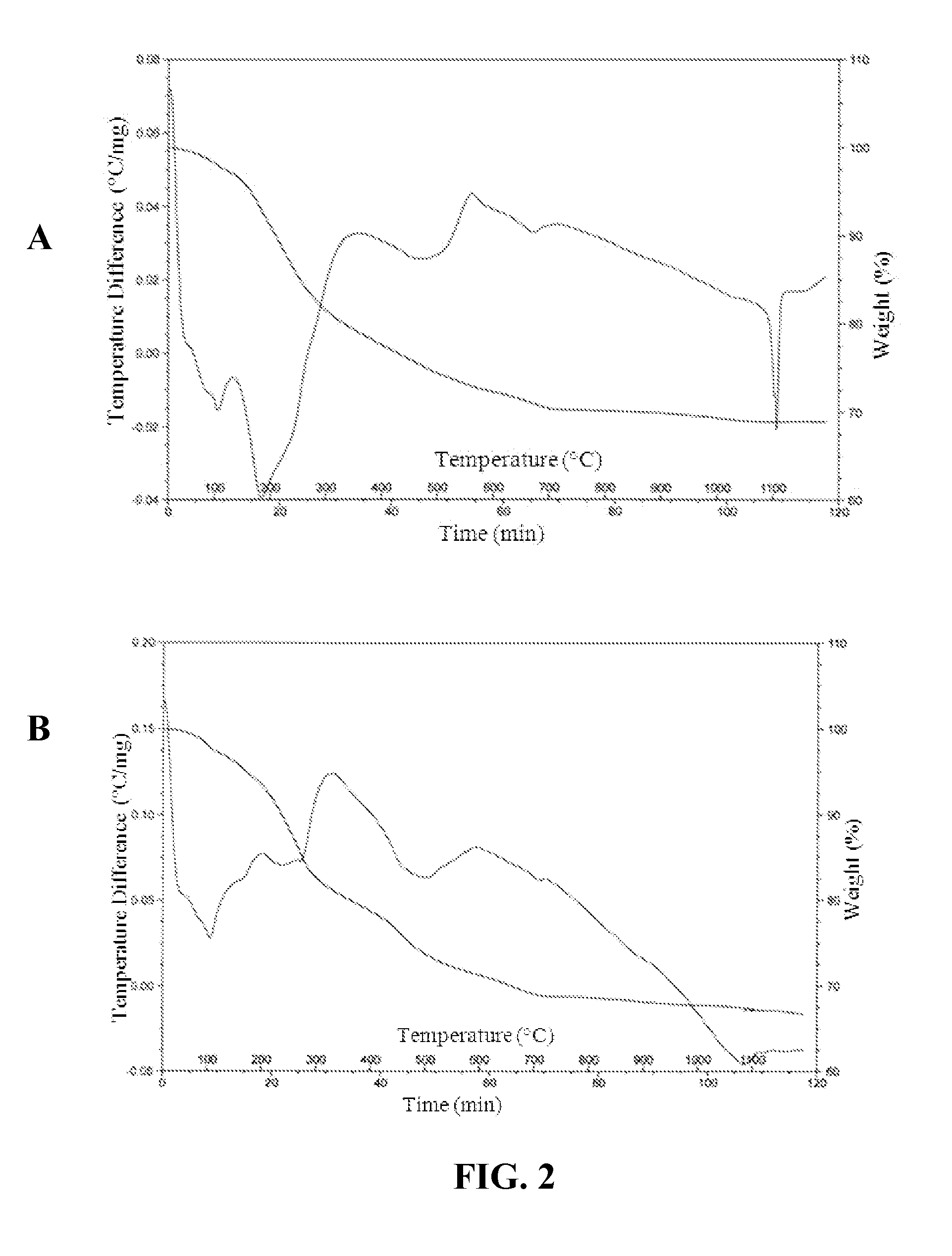Vitrified chemically bonded phosphate ceramics for immobilization of radioisotopes
a chemical bonding and phosphate ceramic technology, applied in nuclear engineering, radioactive decontamination, etc., can solve the problems of limiting the acceptance of alternative technologies by stakeholders and other interested parties, and affecting the practical utilization of glass vitrification
- Summary
- Abstract
- Description
- Claims
- Application Information
AI Technical Summary
Benefits of technology
Problems solved by technology
Method used
Image
Examples
example 1
Vitrified CBPC Immobilized Waste Form
[0036]Simulated Hanford tank sludge (KE basin sludge) was incorporated in CBPC and vitrified. This sludge contains trace levels of hazardous metals such as Cr, Cd, Pb, traces of actinide simulants, and non-radioactive Cs and Sr in place of the fission products Cs-137 and Sr-90, as well as oxides of major elements such as Al, Ca, Mg. Ba and the like. This simulated waste was crushed to a fine powder and was incorporated in a CBPC matrix by mixing with MgO, KH2PO4 and water in the proportions of Eq. 1, described herein. Additional samples were prepared in which the powdered simulated waste was mixed with granulated bottle glass frits in a weight ratio of about 1:9. The glass had the composition: SiO2=65-73 wt %, Al2O3=0.5-10.0 wt %, Fe2O3=0.2-3.0 wt %, CaO=5-12 wt %, MgO=0-3 wt %, P2O5=0-2 wt %, and Na2O=10-17 wt %. The resulting mixtures (with and without glass) were vitrified by heating at about 1200° C. for about one hour. The samples with and w...
example 2
Production of a Vitrified CBPC Radioactive Source with CsCl
[0037]Nonradioactive CsCl was utilized to safely simulate a radioactive CsCl source. Vitrified CBPC-Cs articles were produced with volumes of a few cubic centimeters by the methods described herein. CsCl loadings were about 10 and 15 wt % respectively. Powders of CsCl, MgO, and KH2PO4 were mixed together, and water was added to the mixture with agitation according to the stoichiometric proportion given in Eq. 1. The time interval between the beginning of agitation and solidification was about 5 to 6 minutes. The temperature rose up to 48° C. during this period. Several samples were made this way.
[0038]After the samples had set for about one week, small pieces of the vitrified CBPC were crushed into fine powders and subjected to X-ray diffraction. The diffraction patterns of the two samples are presented in FIG. 1. Panel A of FIG. 1 provides the results for a sample comprising 10 wt % CsCl loading, while Panel B provides the ...
example 3
Effect of High Temperature on Stability of CsCl-Containing CBPC
[0039]The volatility of Cs during vitrification of a CBPC matrix was evaluated using thermogravimetry. DTA / TGA data samples containing 10 wt % and 15 wt % CsCl (FIG. 2, Panels A and B, respectively) indicated that there was no weight loss by the CsCl-containing CBPC samples after heating to 1200° C. other than loss of water of crystallization in the temperature range between 0 and 700° C. Above 700° C., the sample weight remained substantially the same. Endothermic peaks were observed at temperatures of 1106° C. (FIG. 2, Panel A) and 1080° C. (FIG. 2, Panel B), which were due to the sample material melting without any mass loss.
[0040]The structure of the CsCl-containing CBPC materials were investigated using a high resolution microscope after vitrification. The CBPC samples with added cesium were subjected to heat treatment in air at about 1150° C., with a hold time of about 1 hour. The samples (about 2 to 3 grams each) ...
PUM
| Property | Measurement | Unit |
|---|---|---|
| temperature | aaaaa | aaaaa |
| temperature | aaaaa | aaaaa |
| temperature | aaaaa | aaaaa |
Abstract
Description
Claims
Application Information
 Login to View More
Login to View More - R&D
- Intellectual Property
- Life Sciences
- Materials
- Tech Scout
- Unparalleled Data Quality
- Higher Quality Content
- 60% Fewer Hallucinations
Browse by: Latest US Patents, China's latest patents, Technical Efficacy Thesaurus, Application Domain, Technology Topic, Popular Technical Reports.
© 2025 PatSnap. All rights reserved.Legal|Privacy policy|Modern Slavery Act Transparency Statement|Sitemap|About US| Contact US: help@patsnap.com


